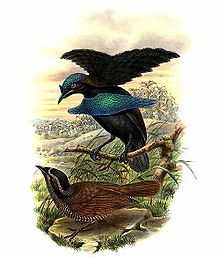Superb bird-of-paradise
| Superb bird-of-paradise | |
|---|---|
 | |
| Conservation status | |
| Scientific classification | |
| Kingdom: | Animalia |
| Phylum: | Chordata |
| Class: | Aves |
| Order: | Passeriformes |
| Family: | Paradisaeidae |
| Genus: | Lophorina Vieillot, 1816 |
| Species: | L. superba |
| Binomial name | |
| Lophorina superba (Forster, 1781) | |
The superb bird-of-paradise (Lophorina superba), is a species of the Paradisaeidae (bird-of-paradise) family. It is the only member in the genus Lophorina.
Description
Lophorina superba is a small, approximately 26 cm long, passerine bird. The male is black with an iridescent green crown, blue-green breast shield and a long velvety black erectile cape covering his back. The female is a reddish-brown bird with brownish barred buff below. The young is similar to the female.
Courtship display
The species has an unusually low population of females, and competition amongst males for mates is intensely fierce. This has led the species to have one of the most bizarre and elaborate courtship displays in the avian world. After carefully and meticulously preparing a "dance floor" (even scrubbing the dirt or branch smooth with leaves), the male first attracts a female with a loud call. After the curious female approaches, his folded black feather cape and blue-green breast shield springs upward and spreads widely and symmetrically around its head, instantly transforming the frontal view of the bird into a spectacular ellipse-shaped creature that rhythmically snaps its tail feathers against each other, similar to how snapping fingers work, (most people thought they snap their feathers against the ground instead) whilst hopping in frantic circles around the female. The average female rejects 15-20 potential suitors before consenting to mate.
Distribution and habitat
The superb bird-of-paradise is distributed throughout rainforests of New Guinea.
Status
Although heavily hunted for its plumes, the superb bird-of-paradise is one of the most common and widespread birds of paradise in New Guinea forests. The superb bird-of-paradise is evaluated as Least Concern on the IUCN Red List of Threatened Species.[1] It is listed on Appendix II of CITES.
Subspecies
- Lophorina superba connectens
- Lophorina superba feminina
- Lophorina superba latipennis
- Lophorina superba minor
- Lophorina superba niedda
- Lophorina superba pseudoparotia[2]
- Lophorina superba sphinx
- Lophorina superba superba
References
- ↑ 1.0 1.1 BirdLife International (2012). "Lophorina superba". IUCN Red List of Threatened Species. Version 2013.2. International Union for Conservation of Nature. Retrieved 26 November 2013.
- ↑ Coyne A., Jerry; Kay H., Emily; Pruett-Jones, Steven (August 2007). "The Genetic Basis of Sexual Dimorphism of Birds". The Society for the Study of Evolution 62 (1): 214-219. doi:10.1111/j.1558-5646.2007.00254.x.
Further Reading
Beehler, Bruce (January 1983). "Frugivory and Polygamy in Birds of Paradise". The Auk 100 (1): 1–12. ISSN 0004-8038.
Coyne A., Jerry; Kay H., Emily; Pruett-Jones, Steven (August 2007). "The Genetic Basis of Sexual Dimorphism in Birds". The Society for the Study of Evolution 62 (1): 214-219. doi:10.1111/j.1558-5646.2007.00254.x.
Donovan, T. A.; Schrenzel, M.; Tucker, T. A.; Pessier, A. P.; Stalis, I. H. (1 May 2008). "Hepatic Hemorrhage, Hemocoelom, and Sudden Death due to Haemoproteus Infection in Passerine Birds: Eleven Cases". Journal of Veterinary Diagnostic Investigation 20 (3): 304–313. doi:10.1177/104063870802000307. PMID 18460616.
Frith, D.W.; Frith, C.B. (1988). "Courtship Display and Mating of the Superb Bird of Paradise Lophorina superba". EMU Austral Ornithology 88 (3): 183-188. doi:10.1071/MU9880183.
External links
| Wikimedia Commons has media related to Lophorina superba. |
| Wikispecies has information related to: Lophorina superba |
- Superb Bird-of-Paradise Video by the Cornell Lab of Ornithology
- BirdLife Species Factsheet
- Video on YouTube
